For this month’s club, we say farewell to summer with four unique and versatile wines from Spain, Italy, and the Finger Lakes, from two different importers: Schatzi and Olé & Obrigado. Schatzi (which we’ve featured in a prior club) represents environmentally conscious, small-scale producers from Austria, France, Germany, Italy, Luxembourg, Slovenia, Switzerland, and New York who “make wines that respect the earth and give voice to terroir.” This is the first appearance for Olé & Obrigado, but next month will feature all wines from this importer, so consider this a sneak peek! The last wine in the line-up includes a brief bio. We hope you enjoy this selection; some of these wines don’t reveal their full selves right out of the gate, so be sure to give them time to blossom–it’ll be worth it.
Cheers!
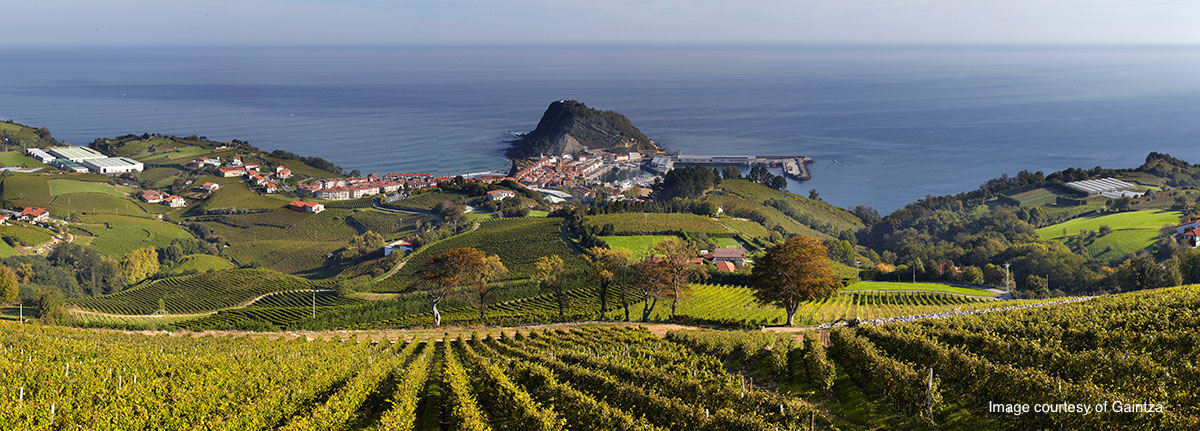
Gaintza Txakolina 2021, Getariako Txakolina, Spanish Basque country
Olé & Obrigado $22.99
Txakoli comes from the Basque country on the cool, verdant Atlantic coast of northern Spain, stretching from the border with Portugal to the border with France; this area, which includes Basque Country, Cantabria, Asturias, and Galicia, is in fact so verdant that it’s referred to as Green Spain–or España Verde. The coastal route starts and finishes near two major international airports, Bilbao and Santiago de Compostela, should you want to make travel plans. This area may be green, but this strip of country facing the Bay of Biscay is also densely populated, heavily industrialized, and not usually associated with wine production. The area's sandy beaches attract surfers and tourists, while the Basque region’s abundance of Michelin-starred restaurants draws millions of destination diners each year. A century ago, though, before phylloxera ravaged the region, over 1000 hectares of vines stretched along the coast, where farming was a struggle then just as it is now; the cool summers and annual rainfall of nearly 60” aren’t necessarily conducive to healthy vines. Nevertheless, there are many farmers within the tiny Getariako Txakolina appellation who have proudly/stubbornly refused to give in to the elements, who have increased the total vineyard area on the rocky Biscay coast, and who have ushered in a vast and welcome improvement in quality since the 1990s.

The Lazkano family has been farming their small vineyard plots around their rural stone house and cellar—known as a caserío—for over a century. The Gaintza estate and winery was founded by Andrés Lazkano in 1923 but the wine was made mostly for home consumption, with the small amounts of leftovers sold directly from his farmhouse to neighboring villages. The winery has expanded since then to include a guesthouse and tasting room on their 25 hectares. It’s run by the 4th generation of Lazkanos, brothers Joseba and Urtzi. Joseba and his mother handle the winemaking while Urtzi manages the family’s 23 ha of sustainably farmed, pergola-trained vineyards. All of them are focused intensely on this small region and its potential for its native varietals.
Like Portugal’s Vinho Verde, Txakolina (or Txakoli) is strongly influenced by the Atlantic and is usually sold young, with low alcohol, and a slight spritz. The wines also have some salty/tangy resemblance to another Atlantic star, France’s Muscadet. The whites here are made primarily from the high-trained Hondaraibi Zuri grape although some French varieties can be found here too; Hondarrabi Beltza makes light reds, mostly (though not always) for local consumption.
Gaintza Txakolina is 85% indigenous Hondarrabi Zuri, and 15% maritime variety Gros Manseng from sustainably farmed vines planted in 1978 on clay and limestone soils, at 75m (246 ft) elevation. It’s fermented slowly, over 45 days, in stainless steel, then aged for 8 months on the lees. This is a classic Getaria-style Txakolina, with refreshing acidity and light effervescence from the natural fermentation finished in the bottle. It’s lean and zesty with lots of lemons, limes, garden herbs, and saline briskness. This is a bit of a wait-for-it wine, as the mouthwatering acidity really hits a bit late and at the back of the tongue. Then it’s dive right in for another sip! Have this wine as an aperitif or with olives, ceviches, anchovies, garlicky shrimp, just about any fried seafood. It’s really a perfect wine for the heat of summer, or if you’re not quite ready to let summer go…
Here's a recipe for Marmitaka, or Basque tuna stew. While it's more of a fall/winter dish, a zippy txakoli would cut right through the richness. Here's a site with a bunch of Basque recipes, but if you're not a fan of seafood, the options are slim. There are some interesting desserts though, like Apple Tart with Thyme Custard.

~pictured above, Element wine crew, care of Schatzi
Element Winery “Can’t Stop / Won’t Stop” 2016, Finger Lakes, NY
Schatzi, $31
The Finger Lakes region is in upstate New York, roughly between Rochester and Syracuse, and is the state’s largest wine growing region, with more than one hundred wineries and countless vineyards planted around Cayuga, Seneca, Canandaigua, Keuka, Conesus, and Hemlock Lakes. Without the lakes’ influence, growing vinifera in this part of the world would be nearly impossible, as the weather conditions are too extreme; not only is there a severe diurnal shift, the summers are very cold, and inversely, the winters are quite mild. These deep, glacial lakes create a lake-effect which help moderate temperatures and deter spring frosts (during shoot development) and fall frosts, leading up to harvest. Melting glaciers dispersed the soils, consisting of gravel, limestone, clay, and silt, over extremely deep shale subsoils that help drain the region’s plentiful rain fall. Cool evening temperatures and long hang times help the grapes develop beautiful flavors without the added risk of over ripeness. As a result, the wines are often delicate, balanced, and elegant.
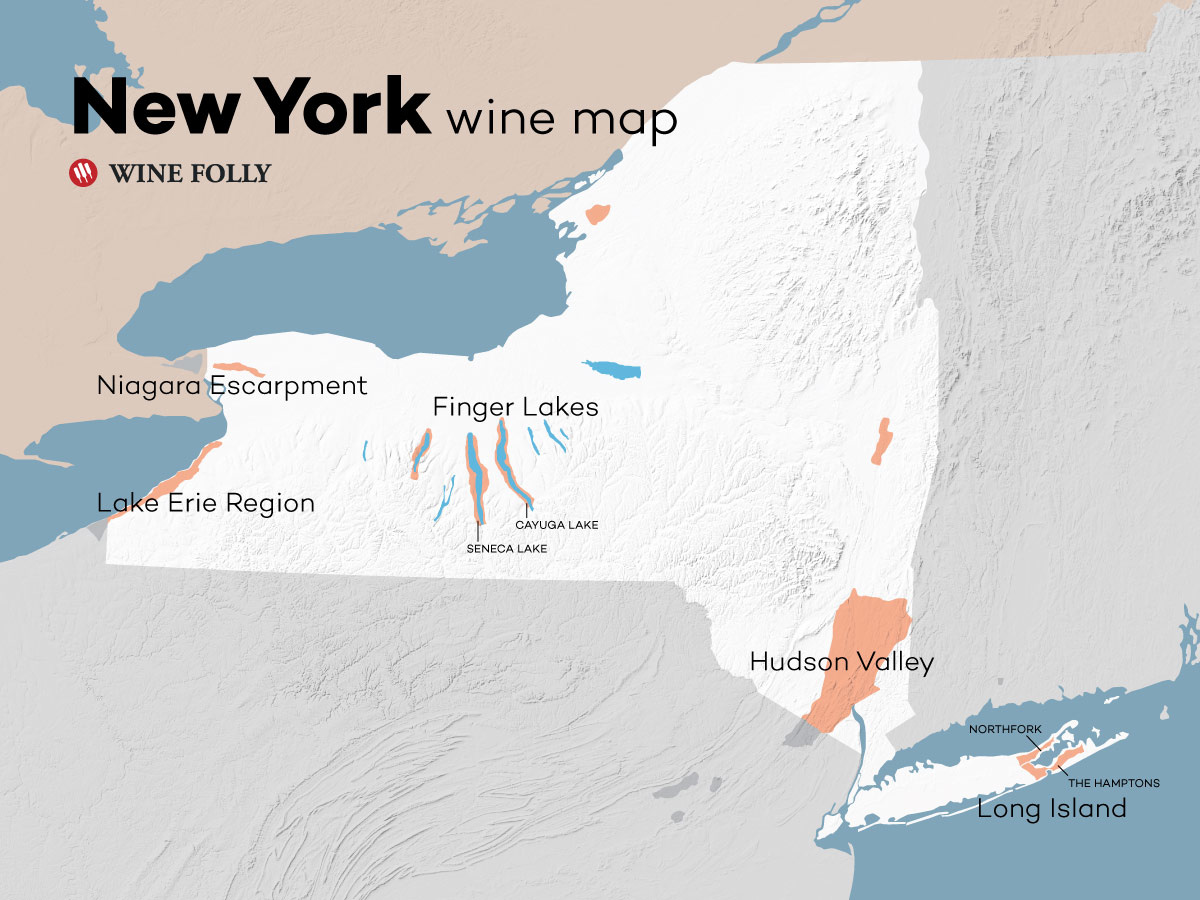
Click here for a more detailed map.
Husband and wife team Christopher Bates and Isabel Bogadtke met in 2004 while working at Mosel, Germany’s historic, highly regarded Weingut Immich Batterieberg. Chris grew up in the Finger Lakes with parents who loved to ferment cider and beer. He’s worked in almost all aspects of the hospitality industry, starting as a dishwasher at 14, then as a busboy, server, and eventually as a cook; throughout his time at Cornell School of Hotel Administration, he worked as a cook at the Statler Hotel, where he had the opportunity to learn from several influential mentors. It was also at this time that he became interested in wine, and with the influence of professors, peers, (and his father, who originally handed him a copy of Wine Spectator) Chris followed his beverage obsession and made a career out of it.
Isabel also started her career in hospitality, though she was mostly focused on service. Growing up in Berlin, she worked for a Relais & Chateaux property in Germany before moving to Frankfurt where she worked at the Michelin starred Brick restaurant.
After harvest in the Mosel, Isabel and Christopher moved to Italy, where Isabel managed a tasting room at Guerrieri Rizzardi during the day and worked with Christopher in a 6 table restaurant at night. She and Christopher spent 7 years managing first The Inn at Dos Brisas, and later the Hotel Fauchere. While at the Inn at Dos Brisas, Isabel was awarded Best Service in the World by Mobil Travel Guide. Isabel is also a Certified Tea Specialist and offers interactive demonstrations on brewing techniques and proper tea service styles for restaurants and hotels.
Upon returning to the states, the couple began to think about dipping their toes into fermenting some of the cool climate fruit that grows in upstate New York; since Christopher’s family had some experience with apples, that’s where they began. In 2006, Chris and Isabel processed their first few tons of apples for cider—they fermented it spontaneously in a makeshift winery at his parent’s house. However, after a few years of production and administrative challenges, they were near ready to give up. That’s when, in 2009, Chris’ father Robert filled an empty tank with riesling as an experiment. As the grapes slowly began to ferment, it became apparent that wine was the direction to follow. After another seven years of experimenting with winemaking and exploring their local terroir, Chris and Isabel purchased their first estate vineyards.
Element’s intention is to make wine with as little intervention as possible, and to always put quality over quantity. They prohibit the use of herbicides in the vineyards and are working hard to naturally restore the biodiversity in the soils. Grapes are picked by hand and are hand-sorted. Wines are fermented slowly and spontaneously without temperature control and whites often go through malo. The grapes are basket-pressed, undergo a short settling and are racked into old, neutral puncheons where they will rest without disturbance until bottling. There are no additions and no adjustments; the wines are unfiltered and unfined.

~image above of Christopher Bates, care of Schatzi
Today, Christopher and Isabel own Element Winery, F.L.X. Table (a small restaurant focused on a communal tasting menu), F.L.X. Culture House (a nano-brewery focused on sours and barrel aged beers), and, in our opinion, a wiener joint worth building a vacation around: F.L.X. Wienery.
Can’t Stop / Won’t Stop is a blend of Cabernet Franc, Pinot Noir, Syrah, Gamay, Merlot, and a touch of Blaufränkisch. It’s vinified in neutral barrique and then aged for 18 months in neutral 318L puncheon. This wine can be enjoyed in its youth when the fruit flavors are bright and forward, or now, as it ages, and the tertiary, earthy aromas are coming to the fore, mingling with chocolate and baking spices. The tannins are pleasant and refined, and the acidity is still vibrant; as the bottle opens up, so do the savory/umami notes which wind around wild strawberry and ripe raspberry, and the tangy/twangy (perhaps VA) nose calms down a bit in the process. As it continues to open, it becomes almost Burgundian. This wine is a journey. Decanting is recommended.
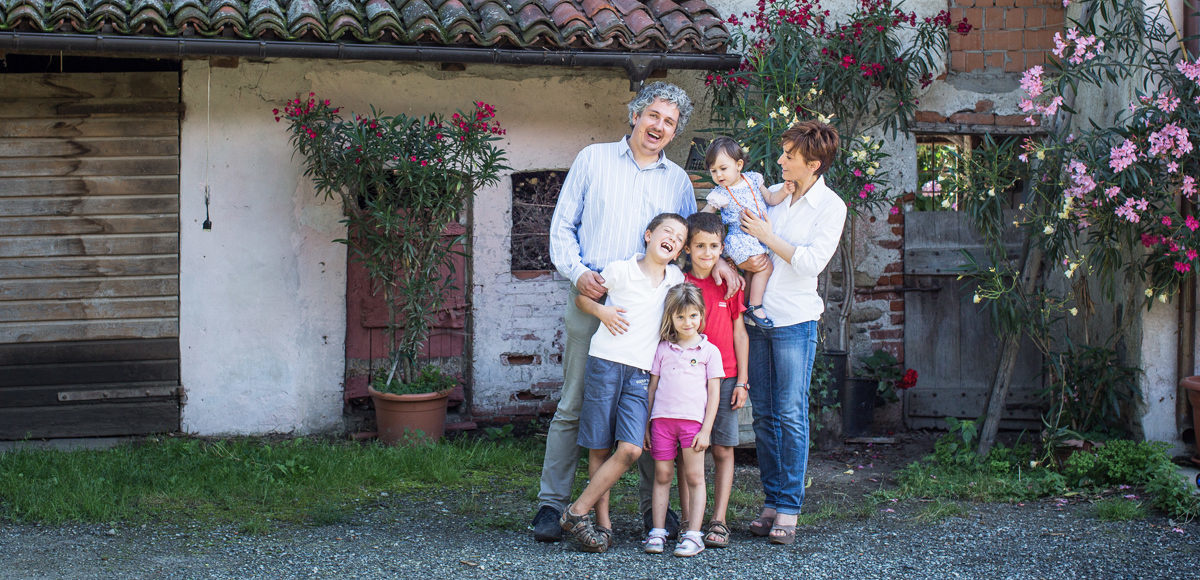
~pictured above, the Fino-Carta family, of Cascina Melognis, care of Schatzi.
Cascina Melognis Pelaverga “Divicaroli” 2020, Piedmont, Italy
Schatzi, $25.99
Cascina Melognis is located in the commune of Revello in the DOC Colline Saluzzesi, in Italy’s northwest Piedmont region. Revello is roughly thirty miles southwest of Turin, and thirty miles from the heart of Barolo; it’s separated from Barolo by a broad plain, cooler weather, and (until recently at least) a much wetter overall climate. This is also a mountainous area with the snow-capped Monte Viso—or Monviso—one of the highest peaks in the Alps, dominating the landscape. This zone was awarded DOC status in 1991, mostly based on the wines made from the very rare Quagliano grape. Quagliano vines can produce copious amounts of very sweet grapes, that in addition to making wine, used to be eaten by locals after meals. The other variety for which this area is known is Pelaverga, which typically grows on sunny hillsides and produces light, spicy, dry reds—though sweet versions do exist—that often have pronounced notes of fresh strawberries.
Since 2008, husband and wife Michele Fino and Vanina Maria Carta have been the humans behind the tiny three hectare property. Michele trained as a lawyer and holds a PhD in Roman law but became a winemaker out of passion, and a grower because he “didn’t want to be the first man of my family not to cultivate a piece of land.” Vanina gained wine experience working at Barolo producer Rocche Costamagna, in La Morra, while Michele has learned on the job and from long-time collaborations with other Piedmontese winemakers.

Cascina Melognis’ high-elevation vineyards are situated at 350-500 meters (1150-1640 feet) above sea level atop poor, acidic soils, and experience stark diurnal shifts. Michele notes that “the landscape is modeled by glaciers, the soils are millions of years older than those of the better known Piedmont hills—very rich in rock, gravel, and sand, very poor in nutrients, but extremely rich in minerals. The soils are therefore adapted to let the vines grow slowly, limit yields, and guarantee specific aromatic evolution of our grapes.”

“We have changed very little from the past,” continues Michele. “The oldest vineyard was planted in 1947, the youngest in 2002. Our philosophy is naturally low yields. That means Guyot training and minimal or no nitrogen fertilizations.” They focus on a handful of varieties native or traditional to the region: pelaverga, barbera, chatus, and pinot noir. Michele and Vanina farm organically, and harvest is done entirely by hand and includes the whole family, from their three kids to extended relatives.
The grapes for Divicaroli are sourced from 30+year-old pelaverga vines. Pelaverga grosso (distinct from the pelaverga piccolo variety of Verduno) is characteristic of the area around Saluzzo; long a staple in blends, its importance diminished over time until it nearly vanished in the 1970s. These days careful site selection and pruning are bringing the grape back from the brink, though it’s still rare to find monovarietal pelaverga from anywhere in the Piedmont, let alone the Colline Saluzzesi.

Pelaverga is late-ripening, and Michele typically harvests in mid-October. The grapes are de-stemmed, then pumped into stainless-steel tank for fermentation and traditional punch down three times a day for the first nine days. After alcoholic and malolactic fermentations, the wine is delicately transferred to another tank for aging until April, when it is bottled.
Pelaverga’s peppery, high-toned freshness, and delicate floral and herbaceous notes are quintessentially Alpine. Pair it with a plethora of pasta dishes, especially those involving mushrooms and/or cream sauce; vegetables roasted with garlic, olive oil, and herbs like rosemary and thyme; it’s a nice pairing for some fish, especially salmon. However you drink it, be sure to put a little chill on it, like they do in Italy.
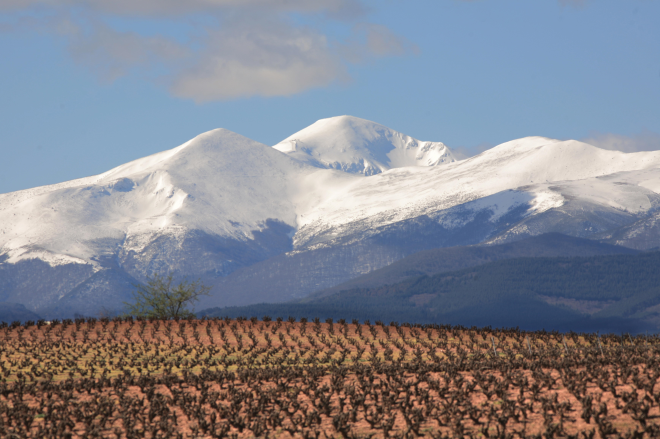
~pictured above, Sierra de la Demanda
La Antigua Rioja Clásico Reserva 2012, Spain
Olé & Obrigado, $30
La Antigua Rioja is just one of many wines produced by Madrid-born Alberto Orte. Back in 1999, while still in college, Alberto and his friend Patrick Mata partnered to form Olé Imports, which became Olé & Obrigado. Both Alberto and Patrick are from families that have been making wine in Spain since the 1800s, so of course the first wines they sold in the U.S. were from Alberto’s family in Montilla, in southern Spain. The two still share duties, with Alberto handling the selection of wines and winemaking in Spain, and Patrick managing the commercial and marketing part of the business in the states.
Alberto has dedicated much of his life to discovering great Spanish terroirs, and rescuing and replanting ancient and nearly extinct varieties that would otherwise be lost. In Jerez alone, Alberto has identified 200+ old clones and 22 forgotten varieties. He produces wine in many regions throughout the Iberian Peninsula, most notably in Jerez, Valdeorras, and Rioja, and tends to favor high-altitude plots with deep soils. He has a passion for old vines, as the lower yields lead to more concentrated and complex flavors in the fruit. He produces two types of wines: wines of unique terroirs, which are labeled as Alberto Orte, and wines from village- designated vineyards that are more approachable, and are labeled as Vinos Atlántico. Today, Alberto owns 16 hectares of vines in Jerez and rents vineyard sites or purchases fruit in the Sil and Bibei riverbanks Valdeorras, Campo Arriba in Yecla, and Sierra de la Demanda in Rioja.

Alberto is serious about organic farming, using beneficial cover crops like clover in the vineyards, and surrounding them with naturally pest-repellant hedges of rosemary. He experiments with biodynamic principles in some of his vineyards, finding that they come alive with worms, pollinators, and other flora and fauna. He uses dry farming techniques instead of irrigation, which is vital in drought-prone areas across Spain. And his new winery at El Aljibe (Cádiz) is powered by geothermal energy; inside the winery itself, he uses an organic approach, allowing the fruit and terroir to shine through in the final product, unmarked by adjustments and chemicals.
La Antigua Clásico shows off the cool-climate, western mountain range of Sierra de la Demanda, a largely unexplored region south of the Ebro river in Rioja Alta. The vineyards here are sparsely scattered and extremely steep, making the terrain impossible to mechanize, thus all work must be done by hand. The north-facing, high-altitude vineyards also receive far less sunshine than those in the valley, so the grapes ripen slowly and are amongst the last to be harvested in all of western Europe; sometimes harvest doesn’t happen until early November. All of these factors, combined with Alberto’s winemaking style that harkens back to the early 20th century, come together to create wines of intense flavor, focus, and freshness, which lead to balanced, age-worthy wines.
With La Antigua Rioja Clasico Reserva, Alberto has brought together old-vine Garnacha (60%), Tempranillo (30%), and Graciano (10%) planted between 1940 and 1955. The vines grow in red silica sandy soils (which is rare in Rioja) at 700 m (2,296 ft) elevation. After vinfication with native yeast, the wine ages for 6 years in 60% French and 40% American oak barrels, 2 years in stainless, then 10 months in bottle.
This wine is beautiful right out of the bottle although decanting would likely allow it to reveal its secrets even sooner. On the nose the tertiary aromas get you first, like leather, tobacco, mushrooms, wet leaves, and just a touch of game. But with some air ripe raspberry and cherry flavors become more apparent, as do the many floral notes. The wine never loses its fresh and energetic character, and the long, fruit-forward finish is enveloped by fine, well-integrated tannins.
Here's Alberto’s recipe to go along with this wine. We can’t wait to try it. Let us know when you do! Apologies to vegetarians…perhaps the next recipe will be meat-free. Although Soy Chorizo really isn’t too bad.
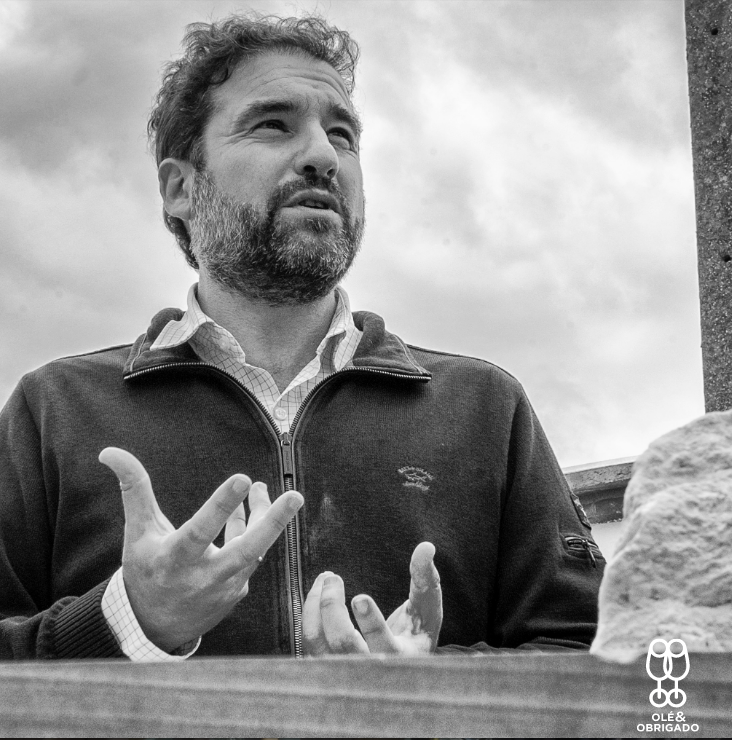
Alberto Orte's PATATAS A LA RIOJANA
This recipe is for a 5# bag of potatoes, which will provide a hearty meal for 4 people with some leftovers if eaten as the main course, or twice that many as a side. Adjust accordingly.
5 lb bag of yukon gold potatoes (russets don’t work for this recipe - needs to be a waxy-style potato)
~2.5 cups of sliced spanish-style chorizo.
One large sweet onion, sliced thinly
4-5 cloves of garlic, peeled and sliced thinly
Generous pinch of saffron.
1 tbsp of spanish smoked paprika.
Water or chicken stock to cover (I use a quart of chicken stock and cover with water, but you can go 100% water; there’s plenty to flavor the broth in this dish)
Bay leaf and sprig thyme, bound in a bundle with twine
Salt and pepper
In a heavy bottomed pot over medium-high heat, saute chorizo until it renders some of its fat and begins to cook.
Add onion and garlic, stir to combine; cook until softened and shiny
In a mortar and pestle (or with your fingers if you don’t have one), gently grind saffron to break it up a little, and add to pan, along with pimenton. Stir to combine.
Add potatoes, stir to coat.
Add water/stock to cover, add herb bundle and season with salt and pepper, bring to a simmer.
Cook until potatoes are tender and beginning to fall apart, about 30-45 mins. Taste every 15 mins for salt - potatoes LOOOOOVE salt and you’ll need more than you think.
Allow to rest for 15-20 mins before eating - this is a dish that is VERY much improved with some time - it’ll be incredibly complex the next day if you have leftovers!
